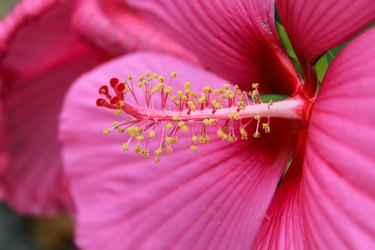
Hibiscus blossoms bring a lush, tropical appearance to your home and garden, but you don't need to live in a warm climate to enjoy them. The hardy hibiscus—native Hibiscus moscheutos, or rose mallow, and imported Hibiscus syriacus, or rose of Sharon—can be grown as far north as USDA plant hardiness zone 5, which includes a lot of decidedly nontropical territory.
Its bushy growth habit makes it a fine and striking perennial flowering hedge, but it's also well suited for use as a potted plant. Container growing lets you place the hibiscus wherever its blossoms and foliage will have maximum visual impact, and it's the kind of low-maintenance plant that doesn't require a whole lot of skill from its grower.
Video of the Day
Video of the Day
Hardy Perennial Hibiscus Basics
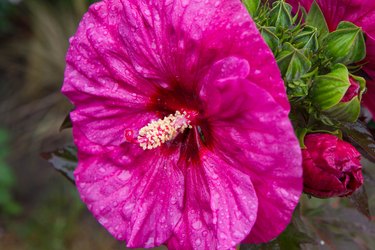
There are two species of hardy hibiscus you can choose for your garden. One is Hibiscus moscheutos, which is native to much of the U.S. and is known as a swamp mallow or rose mallow. It's slightly hardier than its cousins and can sometimes be grown successfully in USDA zone 4. In its wild form, it's a tall, gangling plant, but commercial growers have created modern hybrids that are shorter and more manageable. Depending on the cultivar you choose, you'll see heights from 3 to 7 feet and widths of 2 to 4 feet. The flowers are large—"dinner plate" is often used as the frame of reference—and are available in a range of colors. Many take the form of pale or white flowers with a darker eye, which is especially striking.
The other form of hardy hibiscus that's suitable for colder climates is Hibiscus syriacus, commonly known as rose of Sharon. It can be even taller than H. moscheutos, with some cultivars growing to 12 feet in height, though 6 footers are more common. The blossoms aren't quite as large as those of the swamp mallow, but at 3 to 6 inches in diameter and with both single and double blossoms available, they're still big, beautiful flowers.
Both of these plants are deciduous perennial shrubs with woody stems rather than relatively tender, herbaceous stems, which accounts for much of their durability and winter-hardiness. It takes two to three years for a hardy hibiscus to become well established, perhaps longer if you live at the colder edge of its range, but once established, it's a plant that requires minimal care and only modest protection from winter elements.
How to Start Hardy Hibiscus
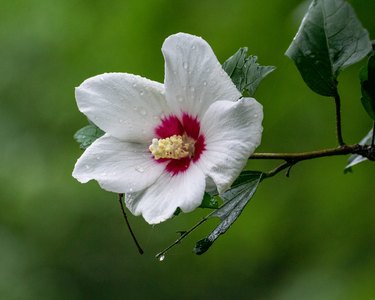
The easiest way to start your potted hibiscus plants is to buy them from a reputable local nursery, all ready to transplant into their permanent home. Starting from seed gives you a wider selection of cultivars, though—you'll have a lot more flexibility in height and blossom color—and it's easy enough for even a novice.
For hibiscus that will live outdoors, you'll need to plant four to six weeks before the last frost. (The timing doesn't really matter with indoor plants as long as they get full sun.) Start by lightly sanding (scarifying) and soaking the seeds overnight; both steps are optional, but they'll make germination faster and more reliable. Plant seeds 1/2 inch deep in well-draining potting soil or seed-starting mix. Leave them in a sunny spot and keep them lightly watered. You should see germination in three to five days. After four to five weeks, you can move them to a larger pot but take care not to bend or damage the taproot.
When you're approaching the last frost date for your area, start hardening off your transplants, whether homegrown or store-bought, by bringing them outside every day for a few hours. Start them off in dappled shade and slowly move into full sunlight over a period of days so they have time to acclimate. After a week or so of hardening, they'll be ready to go into their permanent pots. If your hibiscus will only ever be indoor plants, you can skip the hardening step, though it does help make them sturdy, so there's still a modest benefit. Pinching the tip of the main stem once the plant reaches 8 inches in height will help encourage a bushy growth habit.
Tip
A few popular hardy hibiscus cultivars include:
- Midnight Marvel: Dark, vivid red flowers
- Lord Baltimore: Bright scarlet flowers
- Lady Baltimore: Attractive pink flowers with red centers
- Perfect Storm: White flowers with red centers
- Ballet Slippers: White flowers with a red center and a delicate pink at edges of petals
How to Grow Hardy Hibiscus in Pots

For outdoor hibiscus, choose a pot or planter that complements your landscape and has drainage holes built in. If you're at the colder edge of the hibiscus' range, a larger pot is always better because the extra earth provides insulation to protect the roots from frost. If you'll be moving the pots indoors in winter, choose the largest you can conveniently manage. For indoor-only hibiscus, choose a size that's suitable for the place you'll be putting the plant. (They like to be a bit root-bound, so you don't need to go overboard.) Again, drainage is crucial, so choose a pot with a drainage tray or similar arrangement.
Fill your pot or planter with a good-quality, all-purpose, drainage-friendly potting soil to a level that will allow the hibiscus to sit comfortably on the soil surface. Then, take your hibiscus from its nursery pot and set it into the larger pot. Fill your pot to within 1/2 inch of the top with additional potting soil, patting it down gently around the base of your plant. Position the plant in its chosen location indoors or out and then water it until the water drains out of the pot's hole. In dry areas, a layer of mulch on the pot's surface (not touching the plant's stem) can help keep soil cool and conserve moisture.
In most of their growing range, hardy hibiscus plants love full sun, but if you're at the warmer end of their range (zones 8 and 9), they may benefit from a bit of afternoon shade. For outdoor hibiscus in colder areas, position the pot or planter in a spot that's sheltered from the wind and that ideally gets some reflected sun from a wall or other surface. Both will help your hibiscus flourish.
Potted Hibiscus Care Tips
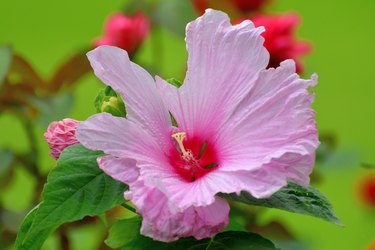
Once plants are fully established (typically from the third year onward), they'll tolerate a moderate amount of drought. Potted hibiscus will need watering more often than their in-ground cousins, though. During hot, dry summers, you might need to water daily, while in cooler regions or years, two to three times per week might be adequate. Your goal is to keep the soil moist but not wet. Hardy hibiscus isn't an especially heavy feeder for its size, but it will benefit from an application of a balanced slow-release fertilizer (a 10-10-10 or 14-14-14) in early spring before new growth appears.
Prune your potted hibiscus to keep it compact and tidy. Be diligent in keeping dead branches cut back and trim long, stray or gangly branches back to the main stem. For optimum flowering, leave two or three nodes on each healthy branch. If your plant suffers frost damage, cut it back to healthy growth in spring (new growth will quickly fill in the empty spaces). Deadheading the blossoms once blossoming starts will help keep flowers coming at a steady clip.
Tip
In the coldest part of the hibiscus plants' range, covering the bare plants with burlap in winter (and wrapping pots themselves with a layer of insulation to protect roots) can help them overwinter with minimal impact from cold.
Aphids, whiteflies, Japanese beetles and spider mites are the biggest threats to your hardy hibiscus plants, but insecticidal soap (or even a strong stream of water from your hose) removes them without threatening pollinators or beneficial insects. Various predatory insects also love aphids and can be bought in bulk from nurseries and garden centers. In some areas, deer might also pose a problem.
Enjoying Your Hardy Hibiscus
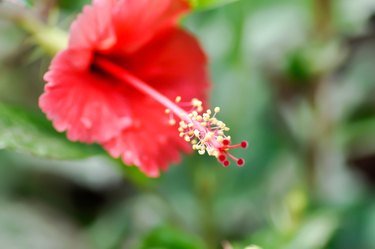
The payoff for all of this work is a beautiful, long-lasting addition to your garden. Your hibiscus will look rather sparse in spring because the deep green foliage doesn't typically arrive until late spring. Blossoms begin to arrive in early summer (in warmer climates) to midsummer (in cooler climates) to late summer (in colder climates). Once your hibiscus blooms, it will keep blooming through late summer into early fall. In other words, once they start, they'll keep going until cold weather causes the blossoms and eventually the leaves to drop.
Because bloom time lasts longer with these hibiscus species than many of your other ornamentals, they're an important late-season food source for hummingbirds and many insect pollinators. The tender young leaves are also edible for humans (you can add those or the petals to a salad), and dried hibiscus flowers make a pleasant herbal tea.

The hardy hibiscus's durability and cold-hardiness makes it a rewarding garden plant whether you grow it in-ground or in a pot, and it's also among the largest and showiest of indoor houseplants. Wherever and however you choose to grow it, it's well worth the minimal effort required.